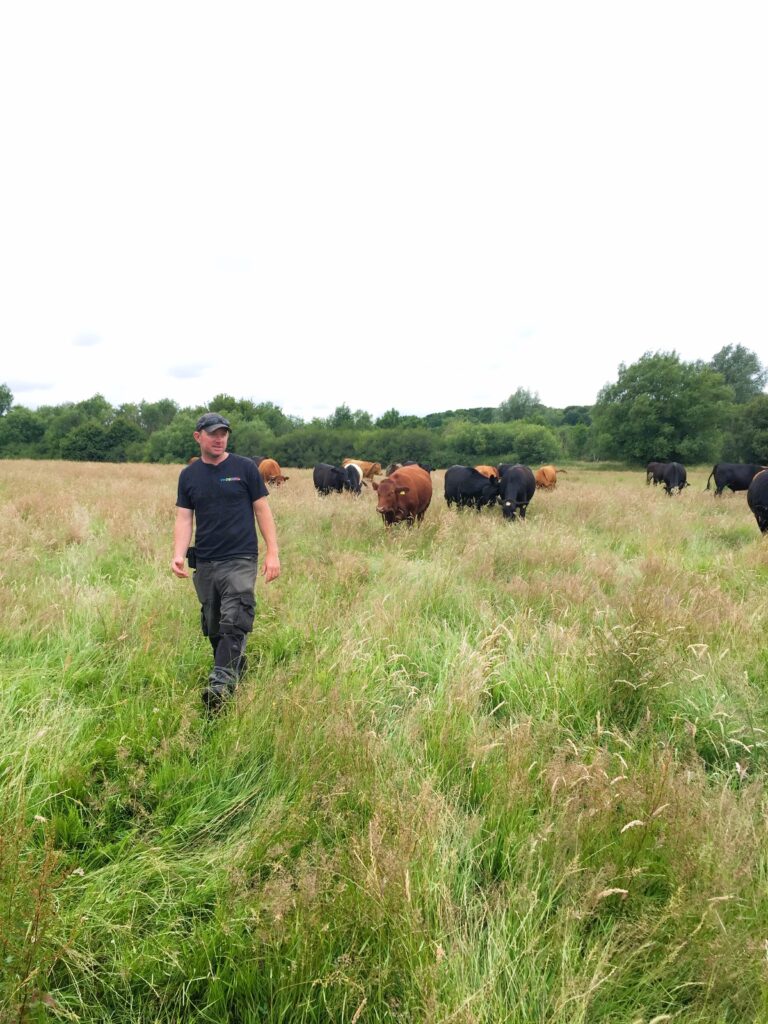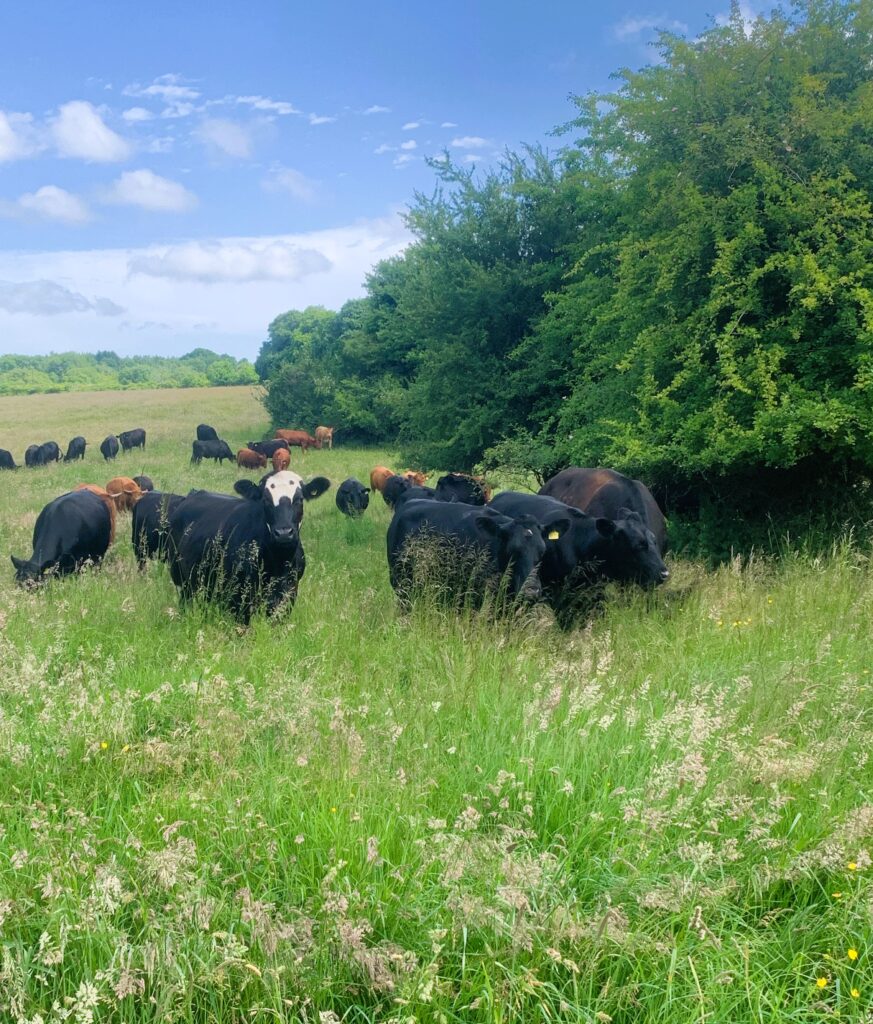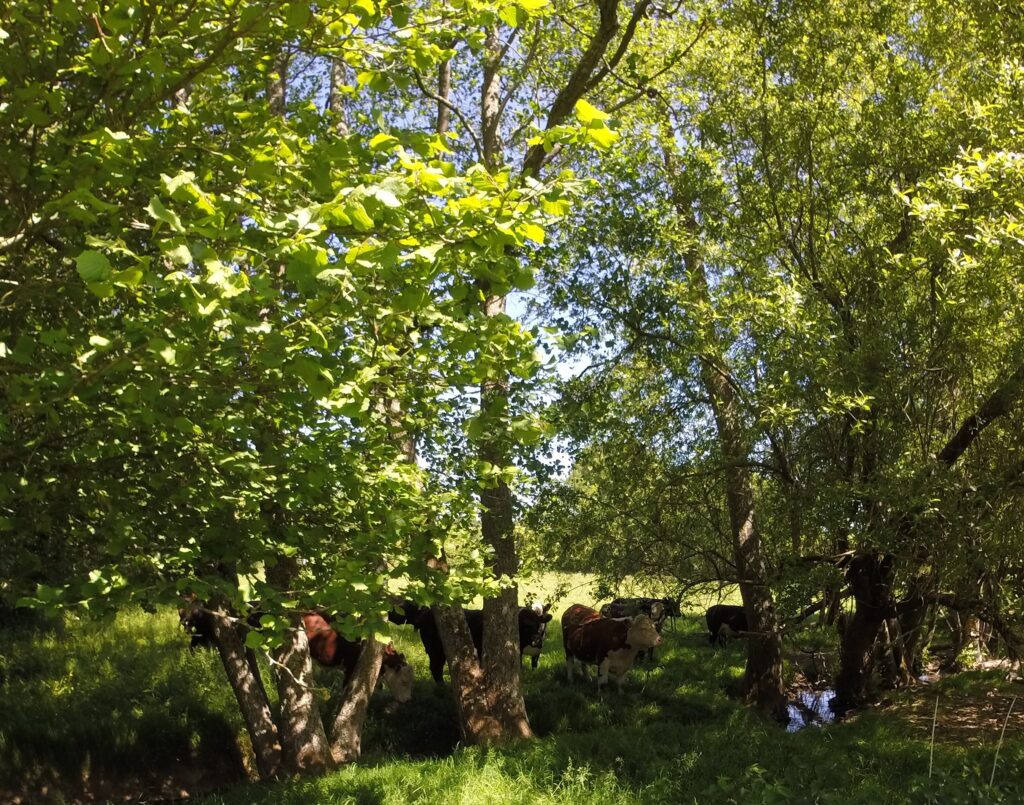Sam and Becky Newington, Limden Brook Organic 1/3
Tell us about your farm

Sam Newington with his cattle
We are located in the centre of the High Weald Area of Natural Beauty AONB in East Sussex, between the River Limden and Rother, grazing permanent pasture including some flood plains. We rent the home farm from Sam’s parents which is 100ha. We also rent 35ha of grazing land from a neighbour and 30ha from a local Nature Conservation Trust much of which is managed as conservation grazing. The farm sits on Wadhurst Clay over Sandstone with an average of 6.4% organic matter. Annual rainfall over the last 3 years averages 820mm.
We moved back to the farm in 2010 and took over management in 2018. We began transitioning from fattening store cattle to a suckler herd over the last couple of years, starting with mainly Red Polls. Last year we added some Sussex heifers and put them to a sturdy little Angus Bull. On average we stock 160 head of cattle and are aiming to increase the suckler herd to reduce numbers of bought in store cattle. All three parcels of land are under Organic certification and we have been Pasture for Life members since 2018 and certified with them since 2022.
Over the past few years we have become more interested in how our farming practices impact the future of the farm as well as the wider community and, as time has gone on, it has become increasingly obvious that agricultural practices can play a huge role in benefitting the sustainability of the planet.
The farm has been certified Organic for a number of years which has always seemed to be a positive approach. But a few years back, even under Organic guidance we didn’t seem to be able to move forwards as we wanted and to escape old practices. At the same time we were having to really analyse the financial side of the business to enable us to continue farming.
After spending time in New Zealand and Australia we had seen the efficiencies and potential other benefits brought about by rotational grazing systems and on returning to the farm had been keen to find ways to put some of these ideas into practice. Our key identified point to cutting costs was to make better use of the grassland. In so doing we could stop feeding concentrates and be able to out winter our animals, thereby reducing the amount of bought in feed and bedding as well as reducing contracting costs. So by implementing a rotational grazing system this plan came into action.
At this point we were lucky enough to stumble across James Daniel who helped us plan and put in our first grazing system and who has been pivotal in guiding our grazing strategies since then. At roughly the same time we began discussions with the conservation trust and High Weald team about regenerative grazing and came across a small group of like-minded farmers to share thoughts and ideas - most of whom are now involved in Pasture for Life.
We mostly sell whole carcasses to butchers in the South East as well as having 1 animal per month for ourselves to sell in boxes or individual cuts from our farm office, trading as Limden Brook.

View over Limden Brook Organic, East Sussex
Share with us a general description of the biodiversity on your farm
It is hard to say how much biodiversity has improved since we began rotational grazing as it is impossible to know if we are seeing new species on the land or whether we are just beginning to notice them with more interested eyes! But there definitely appears to be more stuff out there!
Grassland across the entire farm is reasonably varied, ranging from more productive areas on the home farm grazing platforms, to the lower flood plain areas which spend much of the winter under water. Silage is cut on some of the fields at home and the fields identified for the next years out-wintering have hay cut and left in bales on site ready for winter feeding.
Grasses include meadow grass and perennial rye grass in the main with other grasses such as Yorkshire Fog and Cocksfoot and with meadow flowers such as Yarrow, Vetchlings and Birds Foot Trefoil. On the floodplains Meadow Foxtail is evident as well as reeds and rushes. Orchids can also be seen in some of the pastures.

We are in a well wooded part of East Sussex and benefit from plenty of woodland borders although these are currently not under our management control. Most fields have diverse hedgerow borders of Hawthorn, Blackthorn, Hazel, Hornbeam and Willow, of varying ages and sizes and with Beech, Oak, Alder and Crab Apple interspersed. Dog rose and honeysuckle can be found in the older hedgerows and the Apple trees and Juniper appear to be doing well in the newly planted hedgerows.

The Skylarks have increased in number since we started rotationally grazing, and we now have a couple of barn owls at different sites. Tawny owls and buzzards are prevalent in the area and we have a Kite that visits on occasions and smaller birds of prey can be seen around the flood plain areas. Snipe and woodcock have been present on the flood plains and surrounding land for many years but have also been seen this year on the rotational grazing platforms at home. Bale grazing over winter brings some soil disturbance and keeps the ground clear for small birds such as wagtails, pippets and starlings to forage in.
Swallows and swifts follow the cows through the summer months and appear most days when the cows are moved to a fresh paddock to feed on insects disturbed by the cows. The summer also brings Nightingales, Cuckoos and Turtle Doves to the more wooded and sheltered areas surrounding the grazing paddocks.
Insects and small mammals support this bird life with huge numbers of grasshoppers and crickets and various types of bee and beetles making use of flowering plants in the grassland and hedgerows over the summer months. Dung and water beetles follow the cows around the paddocks in the summer and voles and field mice are seen especially in the bale grazing areas over winter. Dormouse nests are occasionally spotted in the borders and various types of bat have been spotted in the fields and around farm buildings.
In relation to larger mammals, we have plenty of foxes, badgers, moles and fallow and roe deer and the occasional stoat pops up.



